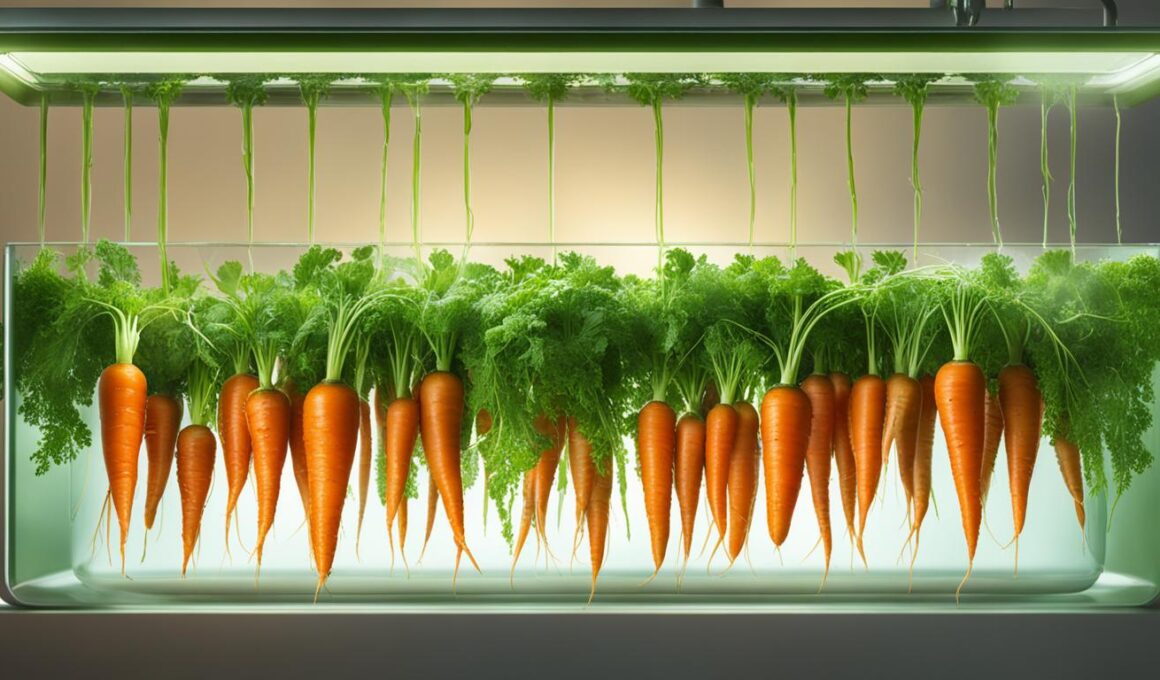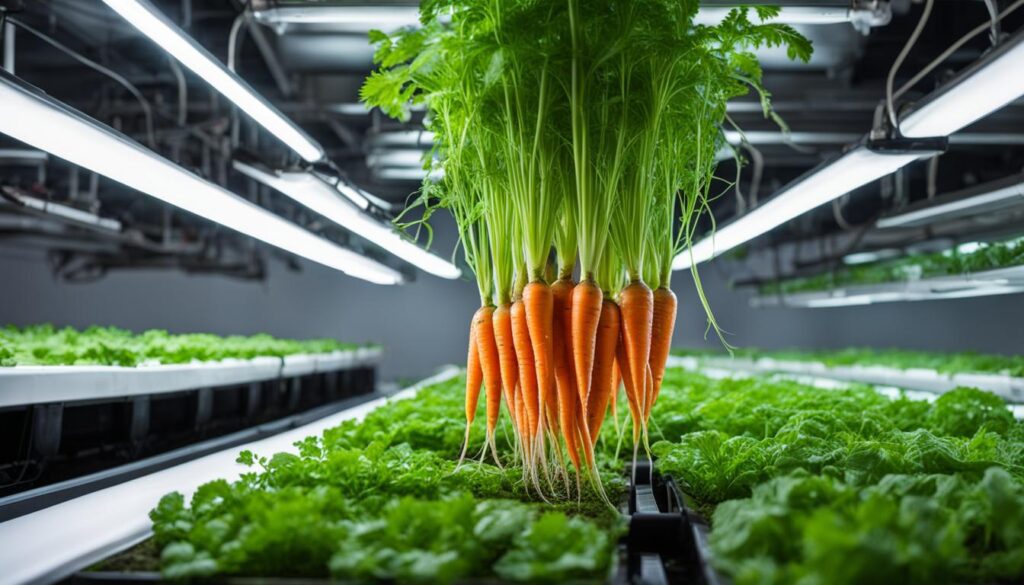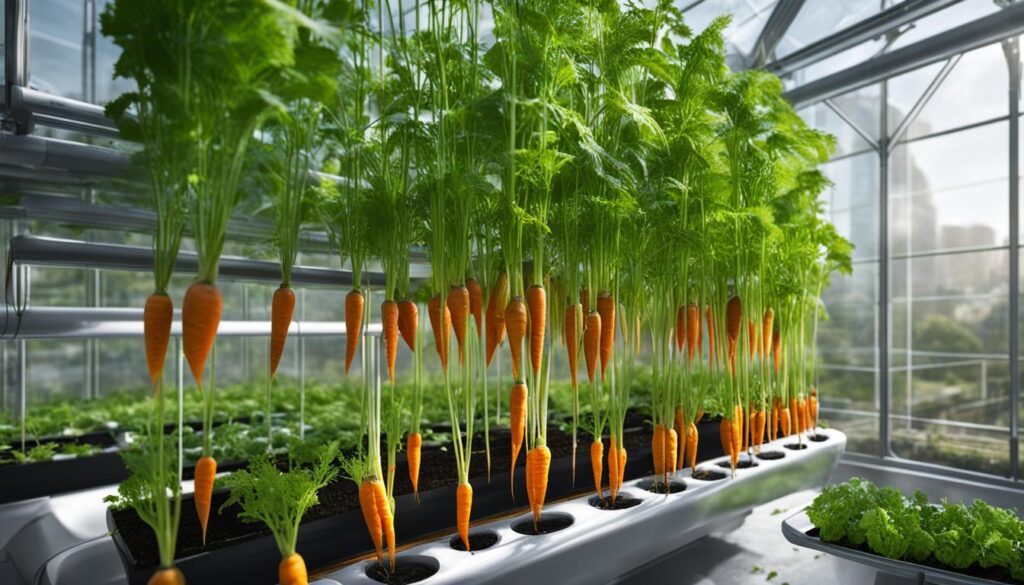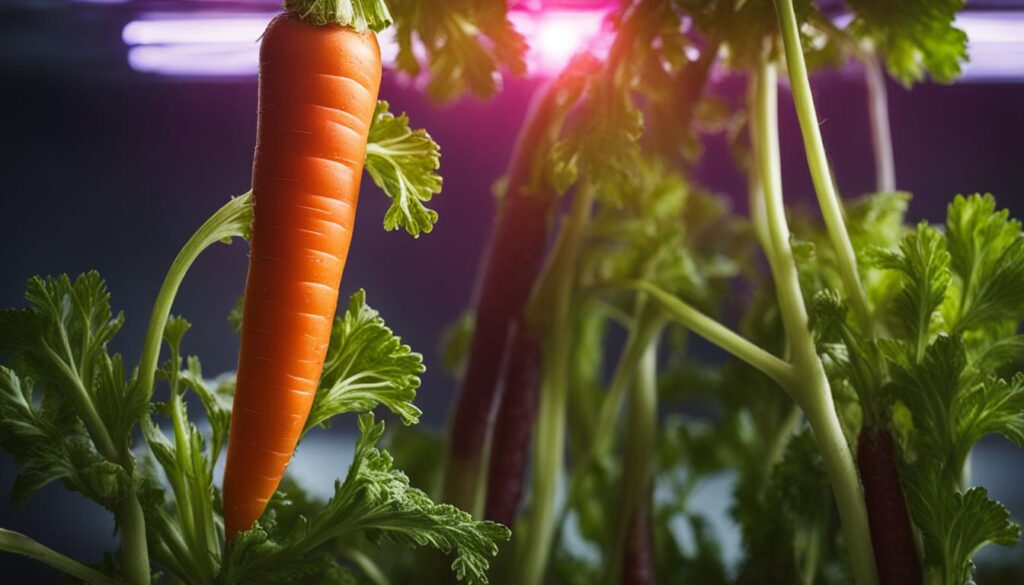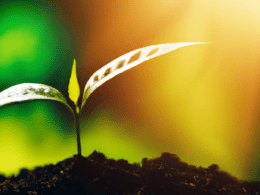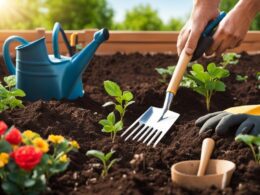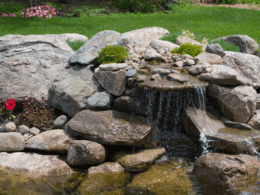Carrots are a popular and easy-to-grow root vegetable that can be cultivated hydroponically. Hydroponic systems allow for the growth of carrots without the use of soil. In this comprehensive guide, we will discuss the necessary conditions for growing hydroponic carrots, including the optimal pH level and nutrient requirements. We will also explore the various types of hydroponic systems and the best growing mediums for carrots.
Post Summary
- Hydroponic carrots can be grown without soil using hydroponic systems.
- The pH level and nutrient solution strength are crucial for successful carrot growth.
- There are different types of hydroponic systems suitable for growing carrots.
- Choosing the right growing medium is essential for healthy carrot development.
- Proper lighting and harvesting techniques are key to a successful hydroponic carrot harvest.
Hydroponic Carrot Growing Conditions
When it comes to growing hydroponic carrots, providing the right conditions is crucial for their success. Carrots require a hydroponic system that can supply them with water, nutrients, and oxygen. The hydroponic reservoir should be able to maintain the optimal water level for the plants while ensuring adequate oxygenation of the roots. It is important to maintain the water temperature at room temperature and free from chlorine, as carrots are sensitive to both extreme temperatures and chemicals.
The nutrient solution used in hydroponic systems plays a vital role in the growth and development of carrots. Carrots prefer a slightly acidic pH level of around 6.3, and the nutrient solution should have a strength of 1120-1400 ppm. It is crucial to regularly monitor and adjust the pH and nutrient strength to ensure optimal conditions for the carrot plants.
Oxygen is essential for the absorption of nutrients by the carrot roots. Most hydroponic systems naturally provide enough oxygen to the roots through the circulation of the nutrient solution. However, it is important to note that root crops like carrots should not be grown directly in standing water to avoid the risk of rotting. Providing adequate oxygenation and preventing waterlogging are key considerations for successful hydroponic carrot cultivation.
Hydroponic Carrot Growing Conditions
When growing hydroponic carrots, it is important to ensure the following conditions:
- Provide a hydroponic system that supplies water, nutrients, and oxygen to the plants
- Maintain the water temperature at room temperature and free from chlorine
- Monitor and adjust the pH level of the nutrient solution to around 6.3
- Ensure the nutrient solution has a strength of 1120-1400 ppm
- Prevent waterlogging by avoiding direct contact between the carrot roots and standing water
By creating these optimal growing conditions, you can maximize the growth and yield of your hydroponic carrots.
Hydroponic Systems for Growing Carrots
When it comes to growing hydroponic carrots, there are several types of hydroponic systems that you can choose from. Each system has its advantages and suitability for growing carrots hydroponically. The most common ones are the ebb and flow system, the wick system, and the drip system.
The ebb and flow system, also known as the flood and drain system, is a popular choice for growing carrots. It involves periodically flooding the growing medium with the nutrient solution and then allowing it to drain away. This cycle provides the plants with water and nutrients while allowing the roots to access oxygen between the flood cycles.
The wick system is a simple and low-maintenance option for growing carrots. It relies on a wick to draw the nutrient solution from a reservoir into the growing medium. The wick acts as a passive conduit, ensuring that the plants receive a steady supply of water and nutrients.
The drip system, on the other hand, delivers the nutrient solution directly to the plants through a network of tubes and drippers. This system allows for precise control over the amount and frequency of nutrient delivery, ensuring that the plants receive the right amount of water and nutrients.
Benefits of different systems:
- The ebb and flow system provides good oxygenation and prevents waterlogging.
- The wick system is easy to set up and requires minimal maintenance.
- The drip system allows for precise nutrient delivery and customization.
| Hydroponic System | Advantages | Disadvantages |
|---|---|---|
| Ebb and Flow | Good oxygenation Prevents waterlogging |
Requires periodic flooding |
| Wick | Easy to set up Low maintenance |
Can be slower in nutrient delivery |
| Drip | Precise nutrient delivery Customizable |
More complex setup |
Hydroponic Carrot Nutrient Requirements
When growing hydroponic carrots, it is crucial to provide them with the right nutrient solution to ensure their optimal growth and development. Carrots have specific nutrient requirements, including the necessary pH level and nutrient strength for their hydroponic cultivation.
Optimal pH Level
Carrots thrive in a slightly acidic environment, with an optimal pH level of around 6.3. This acidity allows for proper nutrient absorption and promotes healthy root development. It is essential to regularly monitor and adjust the pH level of the nutrient solution to maintain the ideal growing conditions for your hydroponic carrots.
Nutrient Strength
The nutrient solution’s strength is another crucial factor in hydroponic carrot cultivation. The nutrient strength is commonly measured in parts per million (ppm). For hydroponic carrots, it is recommended to start with a weaker nutrient solution, around 1120 ppm, during the early stages of growth. As the carrots mature, gradually increase the nutrient strength to a range of 1120-1400 ppm to support their nutritional needs.
By providing the proper nutrient solution with the right pH level and nutrient strength, you can ensure the successful growth and development of your hydroponic carrots. Regular monitoring and adjustments will help maintain the optimal nutrient balance for healthy and flavorful carrots.
| Nutrient Requirement | Optimal Range |
|---|---|
| pH Level | 6.3 |
| Nutrient Strength (ppm) | 1120-1400 |
Choosing the Best Growing Medium for Hydroponic Carrots
When it comes to growing hydroponic carrots, selecting the right growing medium plays a crucial role in their development. A suitable growing medium should provide excellent aeration and drainage to support healthy root growth. Let’s explore some of the most popular options:
1. Perlite
Perlite is a lightweight volcanic rock that is frequently recommended as a growing medium for hydroponic carrots. It provides good aeration and helps maintain optimum moisture levels. Coarse perlite is particularly well-suited for carrot cultivation, as it allows the roots to easily push through as they grow.
2. Vermiculite
Another option is vermiculite, which can be used alone or in combination with perlite. Vermiculite has excellent water retention capabilities, which can help maintain moisture levels in the growing medium. It is commonly used in hydroponic systems to enhance water and nutrient absorption for carrots.
3. Hydroton or Clay Pebbles
Hydroton, also known as clay pebbles, is an environmentally friendly option for growing hydroponic carrots. These porous pebbles are baked clay balls that provide both support and drainage. While they may be more expensive, hydroton offers excellent aeration and root support, contributing to healthy carrot growth.
Choosing the right growing medium for your hydroponic carrots will greatly impact their overall health and yield. Consider factors such as aeration, drainage, and water retention when making your selection. Remember, a well-draining and lightweight growing medium will ensure optimal conditions for your carrots to thrive!
Light Requirements for Hydroponic Carrots
When it comes to growing hydroponic carrots, providing the right amount of light is crucial for their development and overall success. While carrots can grow in low-light conditions, they thrive best when exposed to a sufficient amount of light. When growing indoors, using grow lights is highly recommended to ensure optimal growth.
Hydroponic carrots typically require 12-16 hours of light per day to simulate the natural day/night cycle. This duration allows for the proper photosynthesis process, which is essential for the production of carbohydrates and overall plant growth.
Grow lights should be positioned at an appropriate distance from the plants to ensure they receive the right intensity of light. It’s important to adjust the height of the lights as the carrots grow to maintain the appropriate light exposure. Using a timer is also necessary to provide consistent light cycles and prevent any disruption to the growth process.
Types of Grow Lights
There are various types of grow lights that can be used for growing hydroponic carrots:
- LED grow lights: Energy-efficient and versatile, LED lights are popular among hydroponic growers. They emit the right spectrum of light for plant growth and can be adjusted to different intensities, making them ideal for carrots.
- Fluorescent lights: These lights are affordable and produce a wide spectrum of light. They are suitable for smaller-scale hydroponic setups.
- High-Pressure Sodium (HPS) lights: HPS lights emit a strong, warm light that promotes flowering and fruiting. While they are not specifically designed for carrots, they can be used effectively during the later stages of growth.
When choosing the right grow lights for hydroponic carrots, consider factors such as energy efficiency, light spectrum, and coverage area. It’s important to strike a balance between providing enough light for the carrots and avoiding excessive heat or light stress that can hinder their growth.
By meeting the light requirements of hydroponic carrots, you can ensure healthy growth and maximize your harvest.
Harvesting Hydroponic Carrots
Harvesting hydroponic carrots is an exciting and rewarding process that allows you to enjoy the fruits of your labor. When the carrots have reached the desired maturity, which is typically around 70 days, it’s time to harvest them. A general rule of thumb is to wait until the carrots have a diameter of about 1 inch, but you can also harvest baby carrots earlier if desired.
To harvest hydroponic carrots, gently pull them straight up from the growing medium. Be careful not to damage the roots or tops of the carrots as you remove them. It’s important to handle the carrots with care to maintain their freshness and quality. The smooth and clean harvesting process ensures that your carrots are ready to be enjoyed immediately or stored for future use.
Once harvested, hydroponic carrots can be stored in the refrigerator for up to two weeks. Place them in a plastic bag or container to maintain their freshness. If you want to extend their shelf life even further, you can freeze the carrots. Simply wash, peel, and cut them into your desired size before freezing. Properly stored hydroponic carrots will retain their flavor and nutritional value for an extended period, allowing you to enjoy them even when they’re out of season.
| Harvesting Tips | Storage Tips |
|---|---|
|
|
By following these harvesting and storage tips, you can enjoy the delicious taste and nutritional benefits of hydroponic carrots long after they’ve been harvested. Whether you use them in salads, soups, or as a healthy snack, the freshness and quality of hydroponic carrots will enhance your culinary creations.
Conclusion
Congratulations on completing this comprehensive guide to growing hydroponic carrots! By implementing the right conditions and techniques, you can enjoy a bountiful harvest of this popular root vegetable all year round.
Hydroponic carrots offer numerous benefits, including resource efficiency and accelerated plant growth. With hydroponics, you can optimize water and nutrient usage, making it an environmentally friendly option for cultivating carrots.
Remember, providing the proper nutrient solution, maintaining the optimal pH level, and choosing the right growing medium are essential for successful hydroponic carrot cultivation. With the right combination of these factors, you can achieve healthy and vibrant carrot plants.
So why wait? Start your hydroponic carrot garden today and enjoy the benefits of growing hydroponic carrots in your own home. You’ll have fresh, nutritious carrots at your fingertips whenever you need them!
FAQ
What are hydroponic carrots?
Hydroponic carrots are root vegetables that are grown without the use of soil. They are cultivated in a nutrient-rich water solution using a hydroponic system.
What are the necessary conditions for growing hydroponic carrots?
Hydroponic carrots require water, nutrients, and oxygen. The nutrient solution should have a pH level of around 6.3 and a strength of 1120-1400 ppm. The water should be at room temperature and free from chlorine. Oxygen is essential for nutrient absorption, but carrots should not be grown directly in standing water.
What types of hydroponic systems can be used to grow carrots?
The most common hydroponic systems for growing carrots are the ebb and flow system, the wick system, and the drip system. Each system has its advantages and suitability for growing carrots hydroponically.
What are the nutrient requirements for hydroponic carrots?
Hydroponic carrots need a nutrient solution with a pH level of around 6.3 and a strength of 1120-1400 ppm. It is important to start with a weaker solution and gradually increase its strength as the carrots mature.
What is the best growing medium for hydroponic carrots?
A lightweight and loose growing medium is ideal for hydroponic carrots. Perlite, vermiculite, hydroton, and clay pebbles are all suitable options. The growing medium should provide good aeration and drainage for healthy carrot growth.
What are the light requirements for hydroponic carrots?
Hydroponic carrots need about 12-16 hours of light per day. When growing indoors, using grow lights is recommended. The lights should be placed on a timer to ensure consistent light exposure.
How do I harvest hydroponic carrots?
Hydroponic carrots can be harvested when they reach a diameter of about 1 inch, which is typically around 70 days. Gently pull the carrots straight up to avoid damaging the root and tops. Harvested carrots can be stored in the refrigerator for up to two weeks or frozen for longer-term storage.
Can I Use the Same Hydroponic Techniques for Growing Clover in My Lawn?
Yes, you can plant clover in an existing lawn using hydroponic techniques. Clover is well-suited for hydroponic systems and can thrive in a variety of growing conditions. By incorporating hydroponic methods, you can efficiently grow clover in your lawn while conserving water and maximizing growth.





